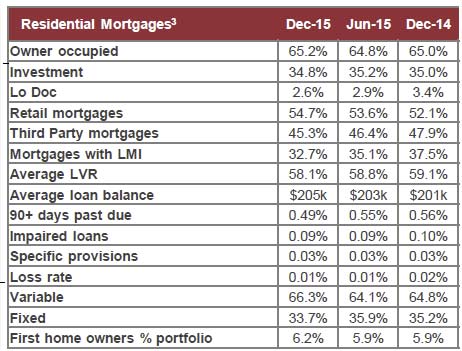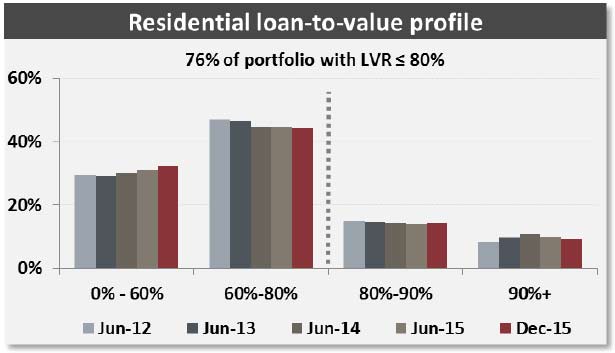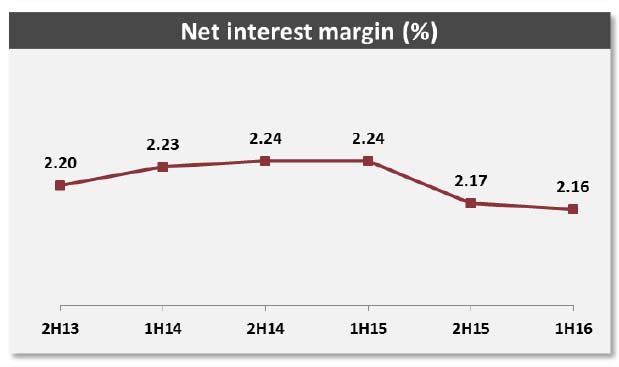Today Bendigo and Adelaide Bank presented their 1H results to December 2015. It has clearly been a tough half, because they are a small player with high penetration into the mortgage sector, in which competitive pricing has taken its toll. One-offs may flatter, but the underlying trends is the business show there is much to be done.
Statutory profit was $208.7m, while underlying cash earnings were $223.7m, up 2.7% on a year earlier. Cost income ratio remained unchanged at 55.6%. Cash earnings per share were up 1.7% on the prior corresponding period. Return on average ordinary equity was 9.10%.
Total lending growth was 1.5%, much slower than system (8.8%), with business lending falling 1.9% and home lending up 3%. Mortgages account for a significant proportion (66%) of the bank’s business, and they specifically mentioned troublesome competitive dynamics.
 35% of loans are investment property lending, 48% via third parties, and 35% fixed rate loans. Overall residential loan arrears (90 days+) was about 1.3% and is creeping higher. High LVR loans are controlled.
35% of loans are investment property lending, 48% via third parties, and 35% fixed rate loans. Overall residential loan arrears (90 days+) was about 1.3% and is creeping higher. High LVR loans are controlled.
 Retail banking’s contribution fell 3.7%, to $97.5m, thanks to a fall in NIM and other income, only partially offset by expenses growth. Customers are using more mobile devices for their banking, whilst PC banking is on the decline.
Retail banking’s contribution fell 3.7%, to $97.5m, thanks to a fall in NIM and other income, only partially offset by expenses growth. Customers are using more mobile devices for their banking, whilst PC banking is on the decline.
Third party banking’s contribution grew 19.4%, to $80.8m, and NIM grew a little, with around $300m a month, and a portfolio on about $16bn.
Wealth contribution a 4.2% increase to $10m, but again exhibited NIM compression. Funds under management reach about $4.5bn.
Agribusiness’s contribution was up 4.1% to $32.8m, but again NIM was compressed.
Homesafe revenues were up to A$54.5m or 17% of earnings, but this included revaluations, and is probably unsustainable. Margins were down and yet the shared equity portfolio is now $550m (doubled from 2013) and the value is linked directly to house price appreciation, which is slowing.
 Deposits grew below system at 2.9%.
Deposits grew below system at 2.9%.
Net interest margin fell by 1 basis point on the prior half year, to 2.16%. The bank suggested mortgage pricing was now a little easier, with monthly NIM trending up.
 However the longer term data shows the pressure the bank is under.
However the longer term data shows the pressure the bank is under.
 Bad and doubtful debt provisions were down 46% to $20.6m.Specific provisions were helped by a fall in Great Southern, but there were rises in retail mortgages and the rural bank.
Bad and doubtful debt provisions were down 46% to $20.6m.Specific provisions were helped by a fall in Great Southern, but there were rises in retail mortgages and the rural bank.
 Total capital increased by 9 basis points to 12.66% and CET1 ratio was 8.24%, up 7 basis points. Work continues to move the bank towards the advanced capital management platform. $64.5m of Basel II costs have been amortised.
Total capital increased by 9 basis points to 12.66% and CET1 ratio was 8.24%, up 7 basis points. Work continues to move the bank towards the advanced capital management platform. $64.5m of Basel II costs have been amortised.
